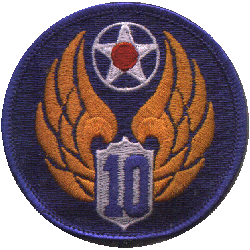(from Aviation History, March 1997 feature)
The IATF was activated 3 October 1942 at Dinjan, India with Col. Caleb V. Haynes commanding. The new task force encompassed all AAF combat units in India, all of which at the time were based at Karachi-the 7th Bombardment Group (Heavy), the 51st Fighter Group, and the recently activated, 15 Sep, 341st Bombardment Group (Medium). Indications were the Japanese were preparing to move north from Myitkyina (Mit' chi na), and 10th AF Staff believed they would bomb the vitally important air installations in Assam. IATF had a dual mission; the original task of defending Assam and now supporting Chinese resistance along the Salween River by hitting enemy supply lines in Central and South Burma.
On paper the IATF had nine squadrons, but not one was fully prepared for combat operations.82 Of the four heavy bombardment squadrons of the 7th Group, the 9th had not yet been returned from the Middle East, the 436th was just receiving its component of aircraft, and the other two, the 492d and 493d, were mere cadres. The recently activated 341st Bombardment Group (M) had only three squadrons in India, and two of them, the 490th and 491st, were without aircraft. A detachment of the 26th Fighter Squadron had moved to Dinjan, but the other squadron of the 51st Fighter Group, the 25th, was in training at Karachi.
The 341st Bomb Group had only a handful of 22d Squadron planes and crews operating in India. The majority had been stripped to assist the 11th Squadron in China. The 22nd was just beginning to receive a full complement of air cadre, and the 490th and 491st were simply support cadres, stripped from the 22nd and without aircraft. The few planes available in Karachi were utilized to complete theater training for incoming crews.
During the summer months the defense of Assam had consisted largely of monsoon weather. As the end of the rainy season neared, Haynes moved the remainder of the 26th Fighter Squadron to Assam and alerted the partially trained 25th Squadron,ss but before the defenses of Assam could be greatly bolstered, the long-expected Japanese assault took place. On 25 October flights of enemy bombers and fighters appeared over targets in Assam almost before warning of their approach was received. Fortunately three American fighters were already airborne and six others managed to take off, but the element of surprise made it impossible for them to throw up more than a token defense. The attack obviously was planned with full knowledge of conditions at the several fields. Dinjan, Chabua, Mohanbari, and Sookerating were all hit, but only the important airdromes at Dinjan and Chabua were heavily bombed. In all, approximately one hundred planes took part in the mission, the bombers releasing their bombs at 8,000 feet to 12,000 feet and the fighters dropping down to 100 feet to strafe. Severe damage was done to runways and buildings, but the most serious loss was in parked aircraft. Five transports and seven fighters were completely destroyed, while four transports and thirteen fighters were badly damaged. Enemy losses consisted of six fighters, two reconnaissance planes, and one bomber. -- (The AAF in World War II, vol IV, Chap. 12, pg. 432)
The October raids on Assam were not repeated; IATF figthers were able to gradually increase the frequency of their mission into Burma as well as the number of planes on the missions. However, the bomber units still lacked planes and personnel and were incapable of doing more than minor harassment of the enemy. Nonetheless, with the late October return from the Middleast of 9th Bomb Squadron (H), with brand new B-24 Liberators, the 1,760-mile round trip to Bangkok became possible, performing two missions there as well as a series of missions to Port Blair in the Andaman Islands before the end of the year.
Japanese aerial forces left these heavies alone but did perform a counteroffensive bombardment in late December, repeatedly attacking docks and shpping at Calcutta and Chittagong, as well as Dum Dum Dum and Alipore Airfields near Calcutta and Fenny Airfield near Feni, India (Bangladesh) which Royal Air Force fighers were ineffective in intercepting. The year ended with the exchange of bombing attacks with neither side meeting effectiver resistance.
By January 1943 headquarters of the IATF had been established at Barrackpore near Calcutta, and the following deployment of combat units was completed: the 25th and 26th Fighter Squadrons were at Sookerating and Dinjan, in Assam; the 436th and 492d Bombardment Squadrons (H) were at Gaya; the 9th and 493rd Bombardment Squadrons (H) at Pandaveswar; the 22nd and 491st Bombardment Squadrons (M) at Chakulia; and the 490th Bombardment Squadron (M) was enroute to Ondal. The newly activated squadrons, though not yet at full strength, were ready to participate in combat, and it appeared that for the first time the Tenth Air Force was in position to challenge Japanese air supremacy in Burma.
Although deployment and training had advanced to a stage permitting combat operations, other fundamental problems had to be worked out before the IATF could hope to achieve success comparable to that of the CATF. The Tenth Air Force as a whole was a fairly well-balanced organization, with one heavy group, one medium group, and two fighter groups. Yet requirements of the task force in China, where many fighters were necessary and only a few bombers could be supported, had left a badly balanced task force in India. Responsibility for carrying out the major phase of the Tenth's mission, protection of the Hump operation, was divided between the two task forces, but enemy deployment and the geography of the theater made it inevitable that the IATF should bear the greater part of this burden. Assam installations were larger and thus more inviting to the enemy than those at Kunming, and while there was a fine air warning system protecting Kunming, the one serving Assam was still rudimentary. -- (The AAF in World War II, vol IV, Chap. 12, pg. 434)
